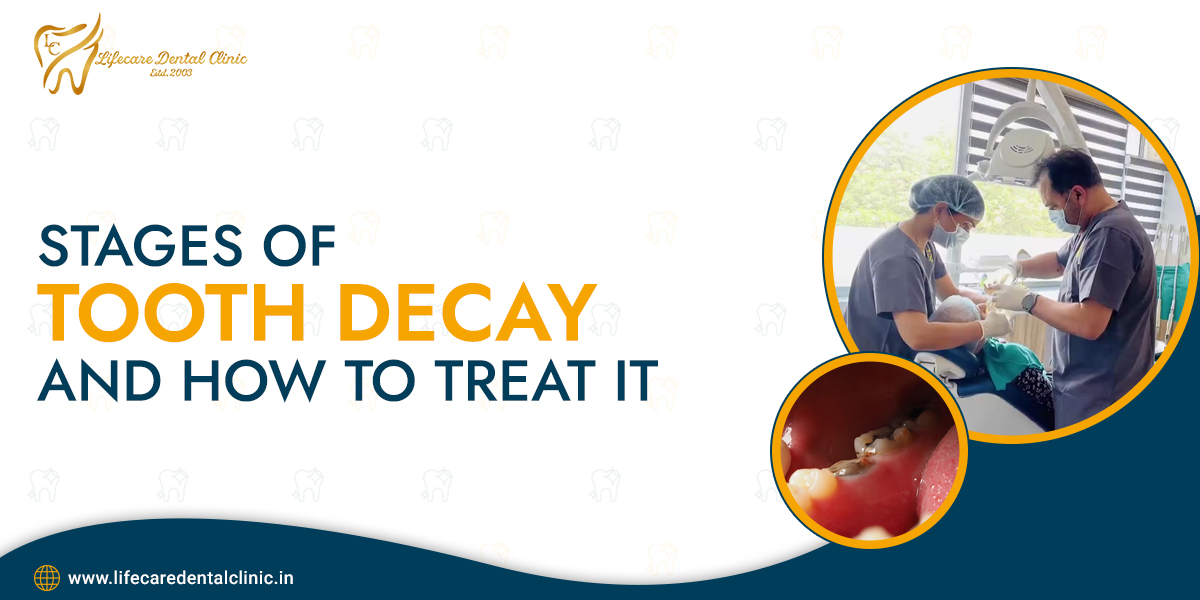Stages of Tooth Decay and How to Treat It

Published Date: September 24, 2024 Last Update: September 26, 2024
Author: Dr. Manpreet S. Walia
Tooth decay, which is also known as dental caries, is a type of tooth damage that often occurred when proper dental care is not taken. This will potentially result in cavities, dental abscesses, or even tooth loss. A decayed tooth progresses through five stages, each requiring different treatment approaches. Understanding these stages is crucial for effective dental care and prevention of severe complications. In this blog, you will know about the stages of tooth decay and how they can be treated, particularly in Chandigarh Clinic.
Stages of Tooth Decay
1. Demineralization
This is the initial stage of tooth decay in which the enamel of the tooth’s outer layer begins to weaken due to acid produced by bacteria in plaque. This stage is often known by the appearance of white spots on the teeth, indicating mineral loss.
Treatment
The damage of the outer surface’s enamel can be reversed at this stage through fluoride treatments, which help remineralize the enamel. With the help of professional fluoride applications at our dental clinic, you can effectively restore enamel health.
2. Enamel Decay
Enamel decay is the second stage of tooth decay. If demineralization is not addressed on time, the enamel continues to deteriorate, leading to brown spots and the formation of cavities. At this point, small lesions may develop within the tooth.
Read This Article - Your Ultimate Guide To Tooth Extraction: Procedure, Aftercare & Recovery
Treatment
Dental fillings treatment in Chandigarh is necessary to treat enamel decay. Our expert general dentist in Tricity will remove the decayed portion and fill it with materials like resin or amalgam to restore your tooth’s structure.
3. Dentin Decay
Dentin decay is the third stage of tooth decay. In this, the decay penetrates the enamel and reaches under the enamel which is dentin (the softer dentin layer). After that, it progresses more rapidly. Symptoms such as increased sensitivity to hot, cold, or sweet foods often emerge.
Treatment
If caught early, depending on the extent of decay the treatment may require a dental filling. If the tooth and inner layer get more damaged, a crown may be required to protect the remaining tooth structure.
4. Pulp Damage
At this stage, decay reaches the pulp which is the innermost part of the tooth containing nerves and blood vessels that lead to severe pain and inflammation.
Treatment
A root canal procedure is typically necessary to remove the infected pulp and alleviate pain. Afterward, a crown is placed over the tooth for protection. Our endodontic specialists are available for root canal treatments when necessary.
5. Abscess Formation
In the final stage, infection can lead to an abscess at the root of the tooth, causing intense pain and potential swelling in surrounding tissues.
Treatment
Immediate treatment of this stage is critical. It may involve a root canal or extraction if the tooth cannot be saved. Antibiotics may also be prescribed by the dentist to manage infection.
Read This Article - How to Treat White Spots on Teeth
Tips To Prevent Tooth Decay
To prevent tooth decay, it is essential to maintain a good oral hygiene routine and make dietary adjustments. Here are some effective strategies to help maintain healthy teeth:
1. Oral Hygiene Practices
-
Brush Twice Daily
Brush your teeth at least twice a day. It is recommended to brush your teeth after meals and before bed. This helps remove plaque and food particles that can lead to decay.
-
Floss Your Teeth Daily
Flossing your teeth is crucial for cleaning between teeth where a toothbrush cannot reach. Aim to floss once a day to remove debris and plaque buildup.
-
Use Mouthwash
Rinse with a fluoride-containing mouthwash after brushing and flossing. This can help reduce bacteria and plaque formation.
-
Regular Dental Visits
Schedule dental check-ups with our expert dentist in Tricity every six months for professional cleanings and early detection of potential issues.
-
Consider Sealants
Dental sealants are protective coatings applied to the chewing surfaces of teeth which can help prevent cavities in children and adults alike.
2. Dietary Recommendations
-
Limit Sugary Foods and Drinks
Reduce the intake of sugary snacks and beverages, as these can contribute to plaque buildup and acid production in the mouth.
-
Stay Hydrated
Drink plenty of water which can help wash away food particles and strengthen tooth enamel.
-
Eat Tooth-Friendly Foods
Incorporate crunchy fruits and vegetables into your diet, such as apples and carrots, which can help clean teeth naturally while providing essential nutrients.
3. Additional Tips
-
Avoid Frequent Snacking
Minimize snacking between meals to reduce the number of acid attacks on your teeth throughout the day.
-
Chew Sugar-Free Gum
Chewing sugar-free gum after meals can stimulate saliva production, which helps neutralize acids in the mouth.
-
Monitor Cavity Risk
Discuss with your dentist your risk level for cavities, which can guide personalized preventive measures.
Implementing the above-mentioned practices can significantly reduce the risk of tooth decay and promote overall oral health.
Read This Article - Benefits Of Dental Sealants For Adults and Children
Conclusion
In conclusion, tooth decay progresses through several stages, starting with demineralization and potentially leading to severe pain and tooth loss if left untreated. Effective treatments vary depending on the stage, from fluoride applications for early decay to fillings and root canals for more advanced issues. By maintaining good oral hygiene practices such as brushing twice daily, flossing regularly, limiting sugary foods, and scheduling your regular cleaning and dental check-up can significantly reduce the risk of developing tooth decay at any stage.

Leave A Reply